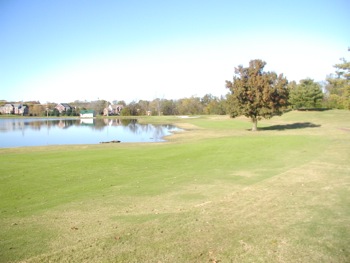
Hole 1
Par 4
As a rule, great golf courses begin with a strong par 4 and Nashville Golf certainly is no exception. The opening hole is a true attention-getter! A 4-star beauty which offers an indication of the various challenges to follow. A player who drives to the crest of the hill is better served if the ball is left of center in the fairway. From this position, the slender green, protected by a lake on the left and bunkers to the right, affords a wider target from approximately 150 yards. Long hitters may choose a target to the right of the fairway driving the ball to the flat. Here, however, the approach shot may be blocked by a large oak tree located 100 yards from the center of the green, making No. 1 without question one of the most difficult holes on the course. Par here is well earned.

Hole 2
Par 4
This straightaway par 4 is played into the prevailing southerly winds. Mounds along the left side of the fairway often protect an errant shot from the out-of-bounds stakes but a well-placed drive is center or right-center. Bunkers are in the front and rear. The contour of the green slopes smartly toward the left front. There is a tendency to under-club on the approach shot. If the pin is located to the left, the landing area shrinks considerably and the rear bunker becomes a prominent factor. In order to have a run at birdie, the ball must be below the hole. A Par here is well earned.
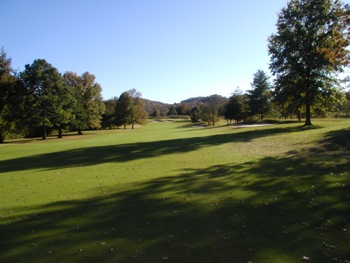
Hole 3
Par 5
The first of 5 pure 3-shot par 5’s on the course. Two fairway bunkers guard the right side of the fairway. The fairway graciously flows with the gentle sloping mounds so the distance of the second shot must be decided in order to determine direction. The third shot from the rough can be disastrous. The undulating green is wide but very shallow. It is designed to accept short iron shots and is protected front and rear by bunkers. The third shot requires pin-point accuracy on club selection. There is no room for error if the pin placement is in the center of the green and little opportunity for a rolling third shot. Contours on the green are fairly easy and 20-foot birdie putts can be made.

Hole 4
Par 4
This hole is often regarded as the strongest of the par 4’s. It is uphill from tee to the fairway landing area requiring both length and accuracy to reach the sharply sloping green in 2 shots. The plateau landing area for the drive is protected on the right by a lateral hazard and the left rough leaves an awkward below your feet stance for a long iron or fairway wood to the narrow entrance of the green. The green-side bunkers are on the right front and rear. This is probably the most deceiving green on the course to read accurately. Long approach putts get out of position very easily. Bogey here quite possible.

Hole 5
Par 4
The shortest of the front nine par 4’s. The strength of this hole is it’s severe slope and lightning-fast putting surface. An elevated tee box provides a perfect view of the dogleg left which requires a 140-yard carry to reach the fairway. The approach shot plays from a position well below the green guarded tightly by bunkers. Your approach shot should be played BELOW the pin. Putts from above the pin are extremely quick and 5-foot birdie putts above the hole can easily become 25-foot par putts. Good birdie opportunity when putting uphill.

Hole 6
Par 3
This is “Our Signature Hole” at Nashville Golf & Athletic Club. The danger here is for a golfer to lose concentration while enjoying the natural beauty of this Par 3. It was included in Sports IIlustrated presentation of the “Great 18 Holes in America!” The star-shaped green is surrounded by bunkers and the entrance is narrow, eliminating chances of a bounce-on shot. The four different tee locations significantly changes how to approach this green. Slope and contours of the putting surface must be understood. Lots of pars, fewer birdies.

Hole 7
Par 5
The fairway bends slightly to the left and is the only par 5 without fairway bunkers. The danger from this tee is to the left and the second shot must be played out to the right to avoid a brook. A fairly long second shot must avoid the two large Stonehenge like rocks on the right side of the fairway. Green side bunkers are to the right front and back left fringe side of the green including a severe slope down to the brook on left side of the green. Good birdie opportunity.

Hole 8
Par 3
The putting surface for this outstanding par 3 is not visible from the tee. The huge bunker at the left front and the elevated right rear bunker afford the player a clear view from trouble. It is uphill all the way and the depressed fairway across the front of the green will hold any ball that lands short of the entrance to the green. A high soft shot sets up a good birdie putt for this gently rolling green.

Hole 9
Par 4
From the tee this hole offers another spectacular view and a truly fine challenge for closing out the front nine. A well placed drive of 215 yards will leave you with a shot around 150 yards to the green. Long hitters who move the ball past the plateau are confronted with a down hill lie to a green both narrow and protected by bunkers front and rear. Again, there is no chance to roll the ball into this putting surface. A missed approach shot brings on a very difficult chip from the bunkers or the fringe. Good opportunity to make par.

Hole 10
Par 3
A lake from tee to green adds zest to this Par 3. Proper club selection is essential because the green is only 42 feet deep, yet over 170 foot wide and there is little room for error off the tee. In addition to the water hazard in front, bunkers at the rear demand accurate club selection. The green is at an angle towards the tee and there is a difference of four clubs depending on pin locations. The left neck of the green leaves no margin for error, so firing directly at the pin can invite a quick double bogey. Play for Par.

Hole 11
Par 4
This is the only Par 4 on the course with a blind tee shot. An acceptable target for the drive is the gap in the far away hills. The fairway is protected by a small forest on the left and a hillside on the right. There is a tendency, as on the 2nd hole, for the golfer to under club their approach iron. A grass green-side bunker is in front of the green and a bunker is at the rear. This enormous green is undulating and extremely quick toward the left side. Pay particular attention in placing the ball close to the hole, rather than the front of the green. A ball left short of the green is almost impossible to get up and down. Best birdie opportunity on the back 9.
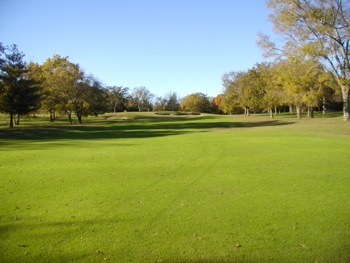
Hole 12
Par 4
The dogleg right challenges #1 and #4 as the most difficult par 4 on the course. Gradually uphill all the way, the fairway is guarded by a bunker on the elbow of the dogleg. Well-placed drives are right center of the fairway presenting a long iron or second shot fairway wood which frequently must clear trees and always carries huge bunkers in front of the green. This is truly one of the most demanding approach shots on the course and without question a true test of golf. Par here gains ground on the field.

Hole 13
Par 5
The high elevated tee contains 13 bunkers along with a boundary out to the right. The fairway is infested with two sets of bunkers which demand your drive and second shot play to the center contour of this abruptly dog-legging fairway. The third shot, approximately 100 yards, is to another green designed for a short approach. Seven bunkers guard all four sides of the green. Pin placement locations vary from a narrow neck on the right to a vast area accommodating several choice pin possibilities on the left. Soft approach shots are definitely required to get the ball close to the hole. Excellent Birdie opportunity.

Hole 14
Par 3
This hole is the least scenic of the five Par 3’s but still plays rather difficult. It can be extremely damaging to the score-card if you are not focused. The right front corner is guarded by overhanging trees with the green partially blinded by the front left green-side bunker. The undulating putting surface slopes to the left. There is a considerable amount of local knowledge involved on this tee shot. Pin placements require a meticulous study for both approach and second putts. Good tee shots produce pars and birdies.
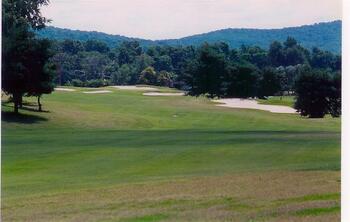
Hole 15
Par 5
This elevated tee affords the luxury for a view of miles of Tennessee countryside as well as the view of this Par 5 and the course lakes in the foreground. The green is reached in two shots more often than any other par 5. Your drive should be placed right center of the fairway for proper position of the second shot. A large, solitary cherry tree must be avoided on the left and a long fairway bunker on the right demands a true second shot. Second shots frequently continue over a slight rise in the fairway and leave short iron shots into the green. There is a tiny passageway between two bunkers at the front of the green. There is a trap at the rear of the green and the decided slope on the right can add to the player’s problems if the shot does not land softly on the green. Three good golf shots are rewarded with short birdie putts.

Hole 16
Par 4
An excellent testy Par 4, this hole includes a double lateral water hazard on the left and three fairway bunkers to the right. The big hitters may gamble on carrying a corner of the lake but a better line is towards the right corner of the second fairway bunker. Again, the huge green, largest on the course, is protected by a series of bunkers front left and right. The putting surface slopes forward and to the right affording numerous, excellent, pin placement locations for the long iron approaches. Big swale contours produce double breakers on 20-foot putts. Bogeys frequent.
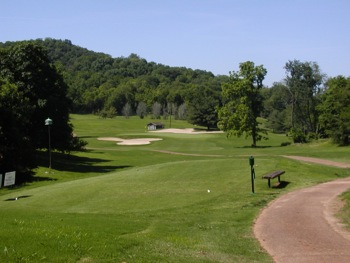
Hole 17
Par 3
A deep bunker in the front and a broad bunker at the rear protect this green which is highlighted by a severely sloping putting surface. A long, high tee shot is required to put the ball close to the hole as there is no chance of a run up shot being effective. The green must be read properly to have any chance of making a birdie. Par here is a common score.

Hole 18
Par 5
This Par 5 can be a round-maker or a heart-breaker. The drive is blind over the slope and most pars come when the opening shot is played on a line toward the willow tree, visible from the tee. A grove of century-old trees overhang the fairway on the right side forcing the second shot to be played cautiously left. Drives frequently come to rest on downhill lies and the player must beware of playing their second shot to the left of the fairway which is protected by two lakes. The green is narrow and over 150 feet long with a sharp appendage right center that is protected by bunkers front and rear. There is a pronounced slope at the front and to the left. The approach shot must be played with caution into the long green protected on the left by the lake. The front bunker blinds the right projection of the green as well as the rear trap and a pin placement here demands accurate distance. The pin location from front to rear offers 4 different club selections for the approach shot. Length and direction must be true for the approach and putts. Birdies can be scored here.

